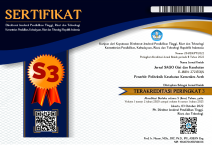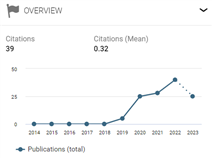Hubungan rasio P(v-a)CO2/C(a-v)O2 terhadap lactate clearance sebagai penanda keberhasilan One Hour Bundle pada pasien sepsis: Pendekatan metode statistik regresi
DOI: 10.30867/gikes.v6i2.2440Abstract
Background: A prognostic predictive value in patients with sepsis and septic shock is needed to determine the aggressiveness of the therapy we will choose. Various methods are used to predict patient mortality. Based on this, a marker is needed to assess tissue perfusion disorders.
Objectives: To determine the relationship between the P(v-a)CO2/C(a-v)O2 ratio and lactate clearance as a marker of the success of the one-hour bundle in sepsis patients.
Methods: This study is a descriptive analytic study of 40 patients who assessed the description of lactate, ScvO2, and PvaCO2 gap values in septic patients. The study was conducted at the Emergency Department (IGD) and Intensive Care Unit (ICU) of H. Adam Malik Hospital Medan, during the period of April to May 2023. The collected data were then analyzed using descriptive statistical methods to calculate the mean, standard deviation, and range of the variables studied. The differences between groups were analyzed using the t-test to compare the mean values of the parameters studied. Correlation analysis was conducted using Pearson’s correlation test to assess the relationship between lactate, ScvO2, and PvaCO2 gap.
Results: At T0, the mean lactate level was 22,06 mmol/L (median 16,85 mmol/L), the mean P(v-a)CO2 was 9,28 mmHg (median 8,50 mmHg), and the mean P(v-a)CO2/C(a-v)O2 ratio was 3,66 (median 3,56). At T1, the mean lactate level decreased to 12,52 mmol/L (median 9,00 mmol/L), the mean P(v-a)CO2 was 8,50 mmHg (median 7,50 mmHg), and the mean P(v-a)CO2/C(a-v)O2 ratio was 3,45 (median 2,57). The average lactate clearance was 48,29%. Bivariate analysis revealed a significant relationship between lactate clearance and the P(v-a)CO2/C(a-v)O2 ratio, with a P-value of 0,009 and a Spearman correlation of -0,521, indicating a strong negative correlation between the two variables.
Conclusion: There is a significant relationship between the P(v-a)CO2/C(a-v)O2 ratio and lactate clearance in the success of the one-hour bundle for sepsis patients.
Keywords
Full Text:
PDFReferences
Abou-Arab, O., Braik, R., Huette, P., Bouhemad, B., Lorne, E., & Guinot, P. G. (2018). The ratios of central venous to arterial carbon dioxide content and tension to arteriovenous oxygen content are not associated with overall anaerobic metabolism in postoperative cardiac surgery patients. PloS One, 13(10). https://doi.org/10.1371/JOURNAL.PONE.0205950
Ahmed, W., & Laimoud, M. (2021). The value of combining carbon dioxide gap and oxygen-derived variables with lactate clearance in predicting mortality after resuscitation of septic shock patients. Critical Care Research and Practice, 2021(1), 6918940. https://doi.org/10.1155/2021/6918940
Chen, H., Zhao, C., Wei, Y., & Jin, J. (2019). Early lactate measurement is associated with better outcomes in septic patients with an elevated serum lactate level. Critical Care (London, England), 23(1). https://doi.org/10.1186/S13054-019-2625-0
Chen, H., Zhu, Z., Zhao, C., Guo, Y., Chen, D., Wei, Y., & Jin, J. (2020). Central venous pressure measurement is associated with improved outcomes in septic patients: An analysis of the MIMIC-III database. Critical Care, 24(1). https://doi.org/10.1186/s13054-020-03109-9
Evans, L., Rhodes, A., Alhazzani, W., Antonelli, M., Coopersmith, C. M., French, C., MacHado, F. R., McIntyre, L., Ostermann, M., Prescott, H. C., Schorr, C., Simpson, S., Wiersinga, W. J., Alshamsi, F., Angus, D. C., Arabi, Y., Azevedo, L., Beale, R., Beilman, G., … Levy, M. (2021). Surviving sepsis campaign: international guidelines for management of sepsis and septic shock 2021. Critical Care Medicine, 49(11), E1063–E1143. https://doi.org/10.1097/CCM.0000000000005337
Gattinoni, L., Vasques, F., Camporota, L., Meessen, J., Romitti, F., Pasticci, I., Duscio, E., Vassalli, F., Forni, L. G., Payen, D., Cressoni, M., Zanella, A., Latini, R., Quintel, M., & Marini, J. J. (2019). Understanding lactatemia in human sepsis. potential impact for early management. American Journal of Respiratory and Critical Care Medicine, 200(5), 582–589. https://doi.org/10.1164/RCCM.201812-2342OC
Gavelli, F., Teboul, J. L., & Monnet, X. (2019). How can CO2-derived indices guide resuscitation in critically ill patients? Journal of Thoracic Disease, 11(Suppl 11), 1528–1537. https://doi.org/10.21037/JTD.2019.07.10
He, H., Long, Y., Liu, D., Tang, B., & Ince, C. (2020). Relationship of relevant factors to P(v-a)CO2/C(a-v)O2 ratio in critically ill patients. The Journal of International Medical Research, 48(1). https://doi.org/10.1177/0300060519854633
He, H. wu, Liu, D. wei, Long, Y., & Wang, X. ting. (2016). High central venous-to-arterial CO2 difference/arterial-central venous O2 difference ratio is associated with poor lactate clearance in septic patients after resuscitation. Journal of Critical Care, 31(1), 76–81. https://doi.org/10.1016/J.JCRC.2015.10.017
KEMENKES RI. (2017). Pedoman Nasional Pelayanan Kedokteran Tata Laksana Sepsis. Kementerian Kesehatan Republik Indonesia.
Ko, B. S., Choi, S. H., Shin, T. G., Kim, K., Jo, Y. H., Ryoo, S. M., Park, Y. S., Kwon, W. Y., Choi, H. S., Chung, S. P., Suh, G. J., Kang, H., Lim, T. H., Son, D., & Kim, W. Y. (2021). Impact of 1-Hour Bundle Achievement in Septic Shock. Journal of Clinical Medicine, 10(3), 527. https://doi.org/10.3390/JCM10030527
Ltaief, Z., Schneider, A. G., & Liaudet, L. (2021). Pathophysiology and clinical implications of the veno-arterial PCO2 gap. Critical Care, 25(1), 1–9. https://doi.org/10.1186/S13054-021-03671-W/FIGURES/5
Lv, D., Zhu, C., & Zhang, K. (2024). Based on P (cv-a) CO2/C (a-cv) O2 and its changes are associated with an early reduction in multiple organ failure in patients with septic hyperlactocidemia. Biotechnology and Genetic Engineering Reviews. https://doi.org/10.1080/02648725.2023.2216541
Sinto, R. (2017). Pemeriksaan kadar laktat pada tata laksana sepsis: apakah benar diperlukan? Jurnal Penyakit Dalam Indonesia, 3(1), 1. https://doi.org/10.7454/JPDI.V3I1.1
Refbacks
- There are currently no refbacks.














